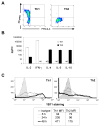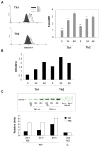Galectin-1 functions as a Th2 cytokine that selectively induces Th1 apoptosis and promotes Th2 function
- PMID: 18991278
- PMCID: PMC2782404
- DOI: 10.1002/eji.200838295
Galectin-1 functions as a Th2 cytokine that selectively induces Th1 apoptosis and promotes Th2 function
Abstract
Galectin-1 has been implicated in regulating T-cell survival, function, and Th1/Th2 balance in several mouse models, though the molecular and cellular basis of its immuno-modulatory activity has not been completely elucidated. Therefore, we examined galectin-1 expression and activity within differentiated murine Th1 and Th2 subsets. While recombinant galectin-1 specifically bound to both T-cell subsets, Th1 and Th2 T cells expressed distinct combinations of galectin-1-reactive epitopes and were differentially responsive to galectin-1 exposure. Indeed, Th1 cells were more susceptible to galectin-1-induced death than Th2 cells. Th2 protection from apoptosis was correlated with expression of anti-apoptotic galectin-3. Further, galectin-1 promoted TCR-induced type 2 cytokine production by Th2 cells. Differentiated Th2 cells constitutively expressed high levels of galectin-1 and can be induced to produce even higher levels of galectin-1 with restimulation, whereas comparable levels of galectin-1 in Th1 cells were only observed after restimulation. Co-culturing experiments using galectin-1(-/-) and galectin-1+/+ Th1 and Th2 T cells demonstrated that Th2-derived galectin-1 induced Th1 apoptosis, whereas Th1-derived galectin-1 promoted Th2 cytokine production. These studies identify galectin-1 as a cross-regulatory cytokine that selectively antagonizes Th1 survival, while promoting TCR-induced Th2 cytokine production.
Conflict of interest statement
The authors have no conflicting financial interests.
Figures







Similar articles
-
Unequal death in T helper cell (Th)1 and Th2 effectors: Th1, but not Th2, effectors undergo rapid Fas/FasL-mediated apoptosis.J Exp Med. 1997 May 19;185(10):1837-49. doi: 10.1084/jem.185.10.1837. J Exp Med. 1997. PMID: 9151709 Free PMC article.
-
Selective expression and functions of interleukin 18 receptor on T helper (Th) type 1 but not Th2 cells.J Exp Med. 1998 Oct 19;188(8):1485-92. doi: 10.1084/jem.188.8.1485. J Exp Med. 1998. PMID: 9782125 Free PMC article.
-
Inhibition of TCR-mediated shedding of L-selectin (CD62L) on human and mouse CD4+ T cells by metalloproteinase inhibition: analysis of the regulation of Th1/Th2 function.Eur J Immunol. 2002 Oct;32(10):2905-14. doi: 10.1002/1521-4141(2002010)32:10<2905::AID-IMMU2905>3.0.CO;2-6. Eur J Immunol. 2002. PMID: 12355444
-
[Molecular mechanism of cytokine gene expression in Th1 and Th2].Rinsho Byori. 1998 Sep;46(9):900-7. Rinsho Byori. 1998. PMID: 9800475 Review. Japanese.
-
Th1 and Th2 cells.Curr Opin Hematol. 2001 Jan;8(1):47-51. doi: 10.1097/00062752-200101000-00009. Curr Opin Hematol. 2001. PMID: 11138626 Review.
Cited by
-
Engineering galectin-glycan interactions for immunotherapy and immunomodulation.Exp Biol Med (Maywood). 2016 May;241(10):1074-83. doi: 10.1177/1535370216650055. Exp Biol Med (Maywood). 2016. PMID: 27229902 Free PMC article. Review.
-
A roadmap for translational cancer glycoimmunology at single cell resolution.J Exp Clin Cancer Res. 2022 Apr 15;41(1):143. doi: 10.1186/s13046-022-02335-z. J Exp Clin Cancer Res. 2022. PMID: 35428302 Free PMC article. Review.
-
Self-assembled glycopeptide nanofibers as modulators of galectin-1 bioactivity.Cell Mol Bioeng. 2015 Sep 1;8(3):471-487. doi: 10.1007/s12195-015-0399-2. Epub 2015 Jun 15. Cell Mol Bioeng. 2015. PMID: 26495044 Free PMC article.
-
Nuclear Galectin-1 promotes KRAS-dependent activation of pancreatic cancer stellate cells.Proc Natl Acad Sci U S A. 2025 Apr 8;122(14):e2424051122. doi: 10.1073/pnas.2424051122. Epub 2025 Apr 2. Proc Natl Acad Sci U S A. 2025. PMID: 40172967
-
Galectin-1 is associated with hematopoietic cell engraftment in murine MHC-mismatched allotransplantation.Front Immunol. 2024 Sep 16;15:1411392. doi: 10.3389/fimmu.2024.1411392. eCollection 2024. Front Immunol. 2024. PMID: 39351218 Free PMC article.
References
-
- Abbas AK, Murphy KM, Sher A. Functional diversity of helper T lymphocytes. Nature. 1996;383:787–793. - PubMed
-
- Constant SL, Bottomly K. Induction of Th1 and Th2 CD4+ T cell responses: the alternative approaches. Annu Rev Immunol. 1997;15:297–322. - PubMed
-
- Glimcher LH, Murphy KM. Lineage commitment in the immune system: the T helper lymphocyte grows up. 10.1101/gad.14.14.1693. Genes & Dev. 2000;14:1693–1711. - PubMed
Publication types
MeSH terms
Substances
Grants and funding
LinkOut - more resources
Full Text Sources
Other Literature Sources
Molecular Biology Databases
Research Materials

